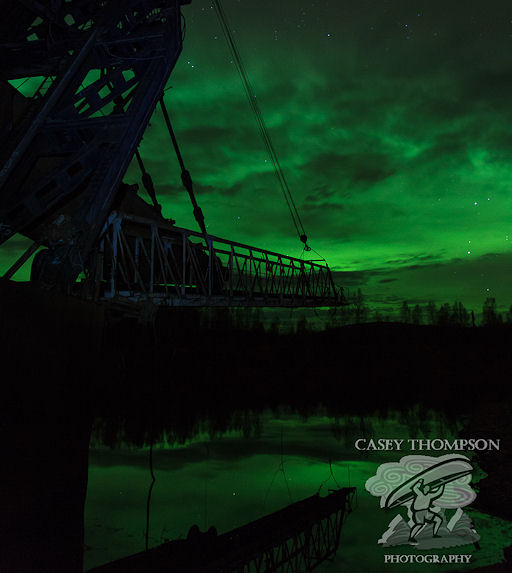SLIGHT CHANCE OF FLARES: Sunspot 1575 has developed a 'beta-gamma' magnetic field that harbors energy for M-class solar flares. NOAA forecasters estimate a 5% chance of an eruption during the next 24 hours. The odds are low, but if a flare occurs, it will be Earth-directed. Solar flare alerts: text, voice.
AUTUMN LIGHTS: The onset of northern autumn means it's aurora season. For reasons researchers don't fully understand, equinoxes are the best times to see Northern Lights. And, right on cue, the Arctic Circle is glowing. Casey Thompson sends this picture from Chatanika, Alaska:
"The auroras beamed right through the clouds over Chatanika on Sept. 21st," says Thompson. "Open water doesnt last long in the interior of Alaska, so it is always nice to find a place to get some reflections of the beautiful Lights along with a staple in Alaska history, the gold dredge."
The solar wind velocity this weekend is low, but at this time of year it only takes a gentle gust to ignite bright auroras around the Arctic Circle. High latitude sky watchers should remain alert for auroras. Aurora alerts: text, voice.

![]()
Solar wind
speed: 363.1 km/sec
density: 2.4 protons/cm3
explanation | more data
Updated: Today at 1526 UT
![]()
X-ray Solar Flares
6-hr max: B9 1315 UT Sep23
24-hr: B9 1315 UT Sep23
explanation | more data
Updated: Today at: 1459 UT
![]()
![]()
![]()
Daily Sun: 23 Sep 12
![]()
![]()
Sunspot 1575 poses a slight but growing threat for M-class solar flares. Credit: SDO/HMI
![]()
![]()
![]()
Sunspot number: 46
What is the sunspot number?
Updated 23 Sep 2012
Spotless Days
Current Stretch: 0 days
2012 total: 0 days (0%)
2011 total: 2 days (<1%)
2010 total: 51 days (14%)
2009 total: 260 days (71%)
Since 2004: 821 days
Typical Solar Min: 486 days
Update 23 Sep 2012
The Radio Sun
10.7 cm flux: 125 sfu
explanation | more data
Updated 23 Sep 2012
![]()
![]()
![]()
Current Auroral Oval:
![]()
Switch to: Europe, USA, New Zealand, Antarctica
Credit: NOAA/POES
![]()
![]()
![]()
Planetary K-index
Now: Kp= 1 quiet
24-hr max: Kp= 1 quiet
explanation | more data
![]()
Interplanetary Mag. Field
Btotal: 2.7 nT
Bz: 2.3 nT north
explanation | more data
Updated: Today at 1526 UT
![]()
![]()
![]()
Coronal Holes: 22 Sep 12
![]()
![]()
A solar wind stream flowing from the indicated coronal hole should reach Earth on ~Sept 23. Credit: SDO/AIA





